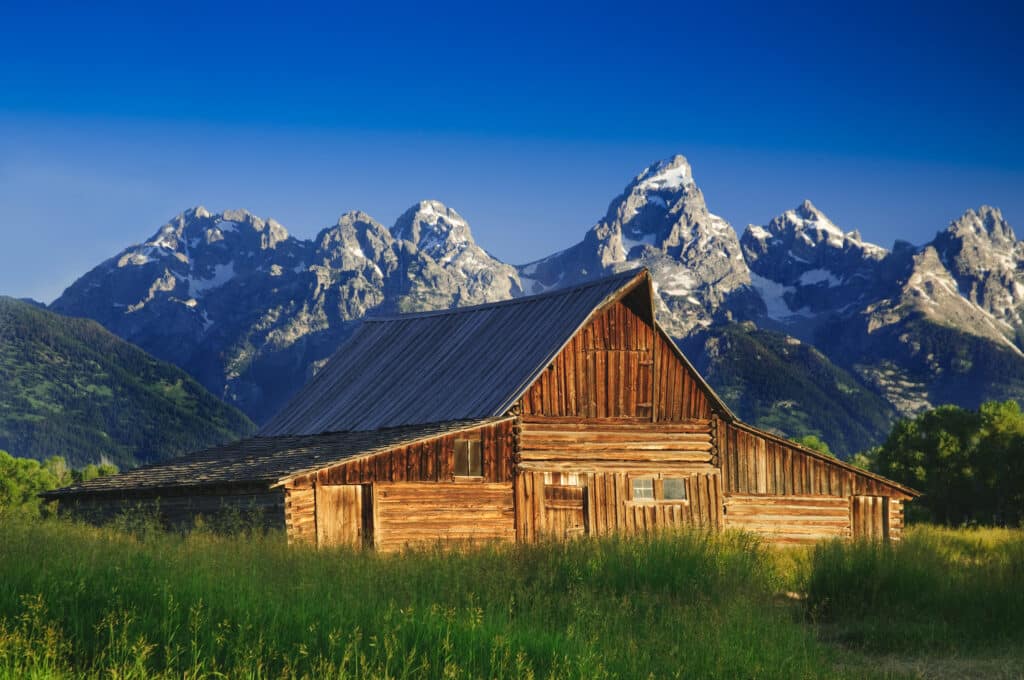
Grand Teton National Park currently charges an entrance fee of $35 per vehicle (private, non-commercial) which allows entry for 7 consecutive days. Motorcyclists pay $30 per motorcycle for a 7-day pass. If you’re entering on foot or bicycle (age 16 and up), the fee is $20 per person for 7 days (children 15 and under are free). These passes are valid for Grand Teton only; if you also plan to visit Yellowstone National Park, you’ll need to pay a separate entrance fee or use a national parks pass.
Frequent park-goers can opt for the Grand Teton Annual Pass for $70, while the America the Beautiful Interagency Pass is $80 and covers all U.S. national parks for one year. U.S. seniors (62+) are eligible for a lifetime senior pass ($80) or annual senior pass ($20), and U.S. military families, veterans, fourth-grade students, and visitors with permanent disabilities qualify for free or discounted passes. Organized educational groups can request a fee waiver.
The park has no timed-entry reservations – just pay the fee and go. Grand Teton National Park is open 24 hours a day, year-round. During the peak summer season (May through September), all park roads, visitor centers, and facilities operate with extended hours, making it easy to explore early or late.
In the off-season (roughly November through April), many facilities and secondary roads close or reduce hours due to winter conditions – for example, the scenic Teton Park Road closes to cars in winter (it becomes a snow trail for cross-country skiing), and all campgrounds and most lodges shut down. Despite these winter closures, the main highway through the park remains open and the park can be visited all year. (The Moose and Colter Bay visitor centers typically operate from spring to fall, closing in winter.) We visited on 04 August 2025, and all figures were valid then.
Park Insights & Highlights
Grand Teton National Park protects a remarkable range of natural features, from soaring mountains to broad valley floors. Ever wondered what makes the Teton Range’s skyline so dramatic? Unlike most mountain ranges, the Tetons have no foothills – the peaks rise abruptly about 7,000 feet above the Jackson Hole valley, creating a stunning jagged profile.
The park was first established in 1929 to preserve these iconic peaks and later expanded in 1950 (thanks in part to philanthropist John D. Rockefeller Jr.’s land donations) to include much of the surrounding valley and critical habitats. Today it spans approximately 310,000 acres of protected wilderness. Geologically, the Teton Range is relatively young (around 10 million years old) and still rising along a fault line, yet it contains some of the continent’s oldest rocks (dated at nearly 2.7 billion years).
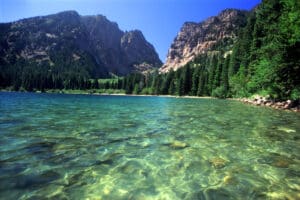
A beautiful day at Phelps Lake in Grand Teton National Park – Wyoming.
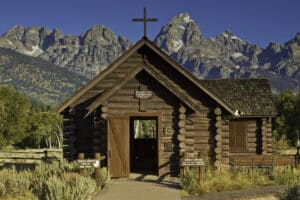
Church of The Transfiguration in Grand Teton National Park
Glaciers from the last ice age sculpted the terrain – carving U-shaped canyons and leaving behind beautiful lakes at the foot of the mountains. In fact, Jenny Lake and the 15-mile-long Jackson Lake were formed by glacial activity and today offer serene, reflective waters that mirror the peaks.
This park is an ecological haven supporting an almost intact Greater Yellowstone Ecosystem. Lush wetlands, sagebrush flats, evergreen forests, and alpine tundra create diverse habitats. Over 1,000 species of plants thrive here, from colorful wildflower meadows in the summer to hardy whitebark pine trees in the high elevations.
The fauna is just as impressive. The valley and forests are home to dozens of mammal species – including grizzly and black bears, large herds of elk and bison, moose grazing in the marshes, pronghorn antelope sprinting across the flats, plus mule deer, coyotes and the occasional mountain lion. Gray wolves have naturally returned to the region as well. Over 300 species of birds have been recorded, ranging from bald eagles and trumpeter swans to tiny hummingbirds in alpine meadows.
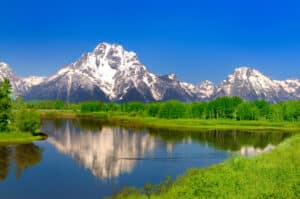
Oxbow Bend at at Grand Teton reflection
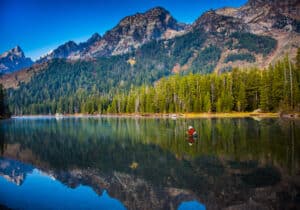
Fly fisherman casts in lake in Grand Teton National Park.
What about endangered species? Park scientists are actively protecting native flora and fauna, such as working to restore native fish populations and to save the whitebark pine (a vital high-elevation tree threatened by disease). Fire management in Grand Teton is also carefully balanced – natural fires are sometimes allowed to burn under watch to maintain healthy forests, but rangers will quickly suppress any wildfire that threatens people or important resources. This strong conservation focus helps ensure the park’s wildlife and landscapes remain unimpaired for future generations.
Grand Teton is a paradise for outdoor enthusiasts. We spent our days hiking and exploring – there are over 200 miles of trails crisscrossing the park. One morning we took the shuttle boat across Jenny Lake and hiked up Cascade Canyon, a spectacular trail where steep granite walls tower above and waterfalls tumble from snowfields.
On another day we did the easy Taggart Lake loop, a 3-mile walk through flower-filled meadows to a tranquil lake right at the base of the peaks (it was an ideal leisurely hike to start our morning). For a shorter stroll, the lakeshore path at Colter Bay offered beautiful views of Jackson Lake with minimal effort. Many visitors spend about two to three days here, which is enough time to see the main sights and fit in a few hikes. If you’re short on time, you can still drive the scenic loop road in one day and stop at the major overlooks, but we recommend at least a couple of days to fully enjoy the park’s offerings. For those with more time (or ambition), longer backcountry treks like the Teton Crest Trail (a multi-day route along the high ridge) provide a deeper adventure. Whether you’re a casual sightseer or an avid hiker, the park’s mix of easy lakeside walks and challenging mountain climbs means there’s something for everyone.
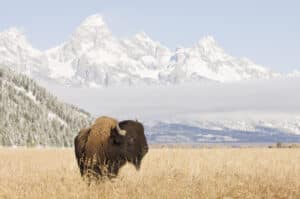
Bison at Grand Teton
We also found early mornings to be especially rewarding (and much less crowded) – wildlife is more active at dawn, and popular spots like Jenny Lake were much quieter before 9 am. Carrying bear spray and knowing how to use it is a must on any trail here, and we advise hiking in groups or making noise in brushy areas to avoid surprising any animals. In our experience, being prepared and respectful of the wild environment really paid off during our Grand Teton visit.
Things to Do & Eat Near the Park
Beyond the well-known highlights, we discovered many other sights both inside and just outside the park that made our trip memorable. Here are some we enjoyed:
-
Scenic Overlooks: We made sure to visit Snake River Overlook, where Ansel Adams famously photographed the winding river with the Tetons in the background – it’s a classic panorama that still looks like a postcard. Another favorite was Oxbow Bend, a calm bend in the Snake River where the mountain reflections and the chance to spot wildlife (often moose or otters) had us reaching for our cameras. At the Mormon Row Historic District, we wandered among old barn buildings from 19th-century homesteads, with the peaks rising dramatically behind the rustic wooden structures – a perfect spot for sunrise photography. We also drove up the winding road to Signal Mountain Summit for a bird’s-eye view of the valley and Jackson Lake spread out below.
-
Additional Activities: Grand Teton offers more than just hiking. We rented a canoe one afternoon at Jenny Lake and paddled in crystal-clear water, feeling tiny amid the towering peaks around us. There are also biking opportunities – a paved multi-use bike path runs roughly 20 miles from near the town of Jackson up into the park. We cycled a section by the Moose area and enjoyed views of open sagebrush flats with the Teton Range right beside us (all without worrying about car traffic on the highway). On another day, we joined a guided float trip down the Snake River, which was a relaxing way to see the park from the water; our guide pointed out bald eagles perched in riverside trees. For campers, the park’s campgrounds (like Gros Ventre Campground near the south entrance or Colter Bay Campground by Jackson Lake) provided convenient bases. We stayed at one and spent the evening listening to a ranger talk and admiring a sky full of stars. The range of activities meant we were never bored – in fact, the challenge was choosing what to do next!
After our adventures in the park, we also explored nearby local spots to eat and relax:
-
Dornan’s in Moose, WY: Just outside the park’s Moose entrance, Dornan’s is a family-run compound that became our go-to for lunch. We enjoyed a hearty buffalo chili and fresh cornbread at their Chuckwagon grill, sitting at picnic tables with a direct view of the Tetons (nothing beats eating with that backdrop!). They also have a casual pizzeria and an old-time general store where we picked up snacks and some local huckleberry jam.
-
Jackson, WY (Town Square area): The town of Jackson is about a 20-minute drive south of the park and offers a great selection of dining and shopping. One evening we treated ourselves to dinner at the Million Dollar Cowboy Steakhouse, a famous western-themed restaurant right on the Town Square – we tried the bison ribeye steak and local craft beer, which were fantastic after a long day of hiking. Afterwards, we strolled under the cowboy-antler archways in the square and grabbed dessert at a local ice cream parlor (the huckleberry ice cream was a delicious regional specialty we had to try). We also spent a lazy morning at Persephone Bakery, a charming café known for its artisan breads and pastries; the coffee and croissants there was top-notch and gave us a cozy small-town feel. Jackson’s shops ranged from outdoor gear outfitters to art galleries. We browsed a few galleries featuring landscape photography and picked up a handmade ornament from a local crafts market as a souvenir. It was nice to mix a bit of frontier-town atmosphere into our national park trip.
Visiting Grand Teton National Park was an incredible experience filled with natural beauty, active adventures, and a touch of Old West hospitality. We left with our camera full of gorgeous photos. We’d highly recommend making the trip out here – it’s the kinda place that leaves you planning you return before you’ve even left.
Sorry, there were no items that matched your criteria.

